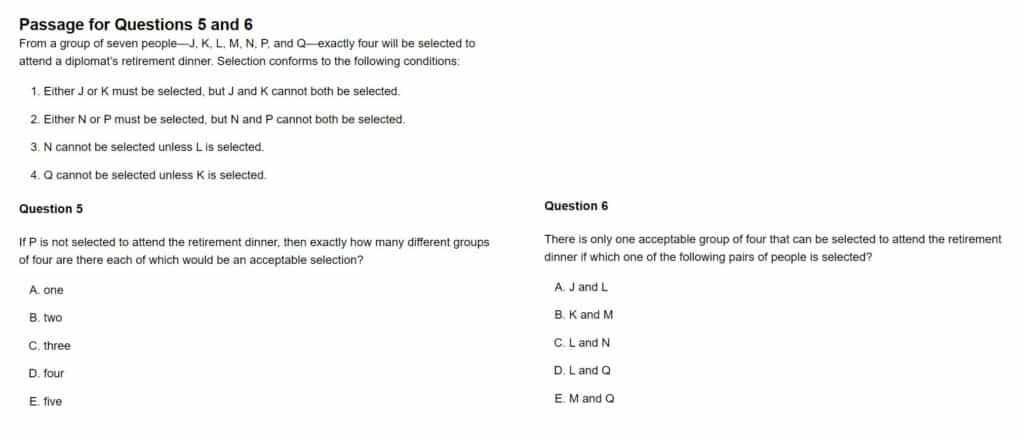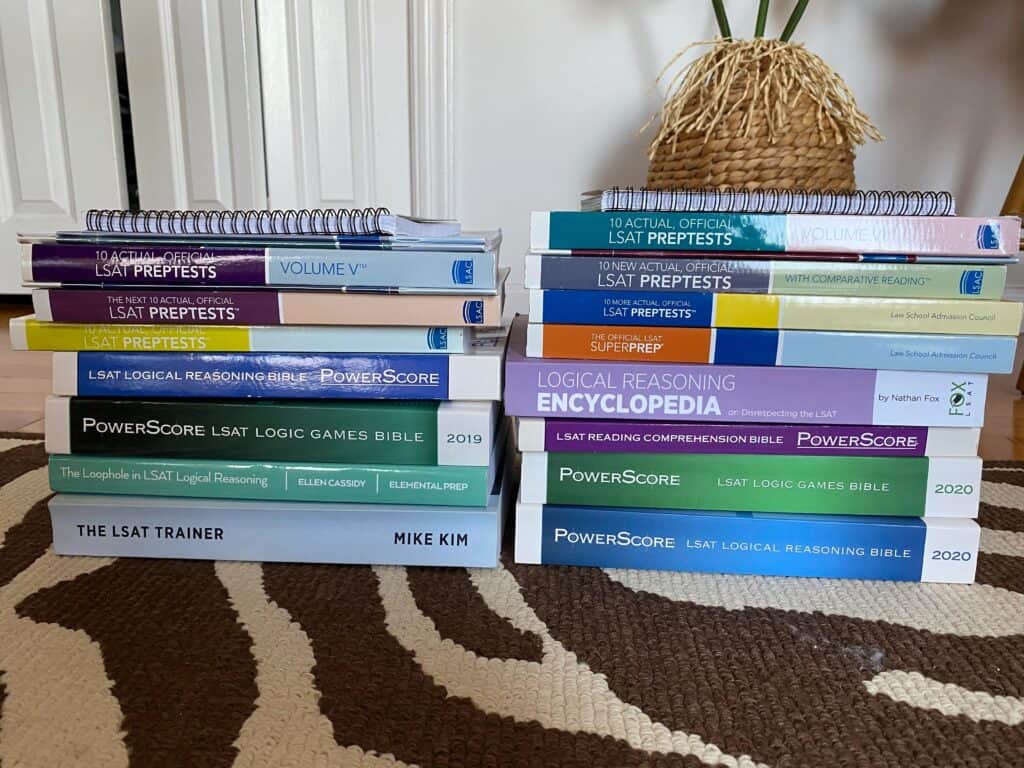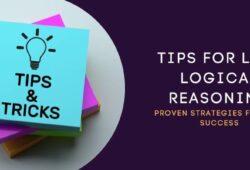There is no easy way to get a high score on the Law School Admission test.
Studying for the LSAT is an incredibly grueling and time-consuming process, and there is no shortcut to it.
You simply have to give yourself ample time to master the necessary skills in making connections, bridging ideas and communicating clearly. Acing the LSAT requires a re-gearing in thinking, training your mind to view things in a certain way.
It sounds simple enough, seeing as you do not need to possess any specialized content knowledge, but it is not that easy.
Anyone who scored above 160 on this test did so because they earned it by learning the best way to study for the LSAT.
Quick Summary
- Studying for the LSAT is all about skill mastery and high-level thinking, as opposed to rote memorization of specialized content knowledge.
- If you are struggling on the LSAT, there could be three main reasons: you aren’t reading carefully enough, you aren’t thinking through the logic critically enough, or you aren’t working hard enough.
- Studying for the LSAT is an incredibly time-consuming endeavor. Be ready to work hard, study consistently, and thoroughly review your mistakes.
- Skills tested on the LSAT are imperative to your success in Law school and your legal career afterwards. So it’s in your best interest to have them down cold.
- The recommended LSAT prep time is about 300 hours or 3 months on average.
- Right from the beginning of your LSAT prep, stick to taking a weekly full-length LSAT practice exam and ensure you review it thoroughly.
What Does The LSAT Test?
The Law School Admission Test, more popularly referred to as the LSAT, tests aptitude and ability rather than specific content knowledge.
The LSAT is designed to test the following skills:
- Reading comprehension skills: The ability to accurately read and comprehend dense blocks of text with the appropriate level of attention.
- Analytical reasoning skills: The ability to organize and manage information and draw reasonable inferences.
- Logical reasoning skills: The ability to analyze and evaluate an argument or short set of facts.
- Critical thinking skills.
- Your capacity to work.
The LSAT consists of 2 key parts. The first part comprises multiple choice questions, and the second part is an unscored LSAT writing sample.
1) Multiple Choice Segment
This portion of the LSAT is divided into the following parts:
- Reading Comprehension Section
This section comprises passage-based questions, with the passages generally relating to Law, Physical Sciences, Social Sciences or Arts and Humanities.
Generally, the passages in this section are densely written, containing high-level vocabulary and sophisticated arguments or complex rhetoric.
The questions will typically require the examinee to determine the author’s main idea, draw inferences from the text, find specific information in the passage, or describe the structure of the passage.
This section aims to measure your ability to read lengthy and complex material with accuracy, understanding and insight, determining the relationships among the various parts of the passage and drawing reasonable inferences from the material presented to you.
- Analytical Reasoning / Logic Games Section

This section comprises ‘games’ contained within a passage scenario, followed by a set of questions. The ‘games’ fall into various categories, such as matching, grouping and ordering elements.
You are given a premise, followed by a set of conditions governing the relationships among the subjects. Then you are required to draw conclusions from the statements presented to you.
The examinee has to consider a set of provided facts and rules and then determine what could or must be true. The key element of this section is that the conditions provided do not produce a single ‘correct’ set of relationships among the entities presented in the game.
As such, this section tests your ability to analyze the range of possibilities embedded in a set of rules, requiring you to apply a range of deductive reasoning skills.
The scenarios presented are usually unrelated to the Law. However, the skills tested by analytical reasoning questions closely parallel the skills involved in determining what could or must be the case, given the terms of a contract, a set of regulations, or the facts of a legal case.
Most test-takers regard this as the hardest section of the LSAT.
- Logical Reasoning / Arguments Section
This section assesses your ability to examine, analyze, and critically evaluate arguments.
You are presented with a set of facts or a short argument, followed by one of the following prompts:
- To find the argument’s assumption
- To identify errors or logical omissions in the argument
- To select an alternate conclusion to the argument
- To choose a statement that would weaken or strengthen the argument
- To find another argument with parallel reasoning.
As such, the main thing tested here is your ability to understand and critique the reasoning contained in arguments.
2) LSAT Writing Segment
This unscored portion of the LSAT is meant to demonstrate your persuasive writing skills.
You are given a prompt containing a decision problem, then are asked to choose between two positions or courses of action and defend your choice.
There are no right or wrong answers here. Rather Law schools will examine your submission based on your reasoning, clarity, organization, language usage and writing mechanics.
As such, you need to demonstrate the ability to organize evidence into a position and then argue logically in writing that is structurally sound.
What Is The LSAT Test Like?
The LSAT is administered 8 times a year, and this proctored test can be administered either online or in person. It’s entirely up to the test-taker based on the option that works best for them.
Unlike many other standardized tests, there is very little memorization involved in preparing for the LSAT. Rather, studying for this exam is more about training yourself to master the required legal skills.
Format
This test consists of 5 sections in total; 4 multiple-choice sections and a writing sample submission.
LSAT Section | Section Type | Scoring | Timing | No. Of Questions |
Reading Comprehension | Multiple-Choice | Scored | 35 Minutes | 26 - 28 Qns. |
Analytical Reasoning | Multiple-Choice | Scored | 35 Minutes | 22 - 24 Qns. |
Logical Reasoning | Multiple-Choice | Scored | 35 Minutes | 24 - 26 Qns. |
Variable / Experimental Section | Multiple-Choice | Unscored | 35 Minutes | 22 - 28 Qns. |
Writing Sample | Writing | Unscored | 35 Minutes | 1 Qn. |
The LSAT is set up such that a test-taker can take the LSAT writing sample at their convenience, as early as 8 days before the date of their Multiple-choice test.
As such, the LSAT exam day only comprises the multiple-choice portion of the exam, totaling to about 3 hours of test time, when you include the 15-minute break provided after the third section.
Another thing to note is that the multiple-choice sections appear in a different order in every single test form of this exam. This is done to deter cheating by making it difficult to guess which is the experimental section.
The experimental section is used to test new questions for future exams. This unscored section can be any one of the question types, i.e. reading comprehension, analytical reasoning, or logical reasoning, and can occur at any part of the test.
Although unscored, the writing section is an equally important part of this test, seeing as it is submitted to Law schools along with your score.
Types Of Questions
Contrary to what many might think, the LSAT does not test whether you know the Law. Rather, this exam is all about games, exercises and interpretation.
The LSAT tests your ability to challenge expectations and be confrontational in the correct way. You need to be able to question possibly flawed conclusions and foretell other p[eople’s conclusions.
How good are you at asking the right questions? That’s what the LSAT is all about, and the questions are similarly fashioned to evoke critical thinking, analytical and logical reasoning from the examinee.
LSAT questions will require you to bridge ideas, make connections, and communicate clearly.
It is more about training your brain to think in a certain way rather than possessing a certain piece of knowledge-based information.
The good news is that this is all learnable through the right combination of focus, training, and perseverance.
What’s The Best Way To Study For The LSAT?
The first step to studying for the LSAT is to determine whether you are better off self-studying, taking a prep course, or hiring a tutor.
You can self-study using prep books, free online resources, and official LSAT material provided by LSAC, whereas tutoring and prep courses offer the advantage of guided prep.
Whichever the case, you need to decide the route you intend to take, then gather the necessary study materials you will need, and develop a plan to work through all of the resources.
1) LSAC’s Official LSAT Prep Materials
The Law School Admission Council provides unlimited practice through your LSAC LawHub account, where you can sign up for a free account, upgradeable at a fee.
The free account comes with 4 full official LSAT prep tests, complete with instant scoring feedback for each practice test. On the other hand, the paid account, costing $115, comes with 1-year access to over 75 LSAT prep tests.
The advantage here is that you get quality practice using authentic LSAT test questions while also gaining familiarity with the official test interface that you will encounter on test day.
The disadvantage is that no official explanations or strategy guides are provided. All you get are the official practice tests.
LSAC additionally has prep books and eBooks containing their previously administered LSATs, complete with an answer key and writing samples for each test, along with score conversion tables.
2) LSAT Prep Books

LSAT books can be dense and rigorous, but they are exhaustive, which is just what you need if you are looking to ace the LSAT.
Some of the more popular options in the market include:
- The LSAT Trainer
- The Loophole in LSAT Logical Reasoning
- PowerScore LSAT Bible Trilogy
- Kaplan LSAT Prep Plus
While trying to find the best LSAT prep book, make sure the one you choose is up to date, offers full coverage and provides detailed explanations of practice questions.
3) LSAT Prep Course
For a little more structure, expert guidance and discipline in your LSAT test preparation, taking a prep course would be a good option.
The key here is to choose a test prep company that’s an official LSAT content licensee as per the LSAC.
Some of the top LSAT prep courses in the market include 7Sage, Blueprint, and Princeton Review among many others.
The key advantage of taking a prep course is that it can save you a lot of time, eliminating the likelihood of wasted effort and maximizing the effectiveness of your LSAT preparation.
At the same time, prep courses come packed with a ton of study resources, including practice exams, detailed explanations, LSAT guides and more.
A few parameters you can use to evaluate the suitability of an LSAT prep course include:
- Do they incorporate the official LSAC study materials?
- Do they offer a personalized study approach tailored to your specific needs?
- How knowledgeable and experienced are the instructors?
- Check verifiable reviews to see what previous test takers have to say about the prep course.
4) LSAT Tutoring
There are several ways you could find an LSAT tutor. These include performing an online search, using a staffing service, asking friends for recommendations, or hiring one through an LSAT test prep company.
Hiring a tutor through a test prep company is typically the most convenient route to take. These tutors are fully vetted and trained, so you get to enjoy peace of mind. The only downside is that this option can be quite expensive.
Nevertheless, individualized LSAT tutoring can be a great help, providing excellent one-on-one coaching on a specific area of the test that you are struggling with.
Better yet, this route allows you to pay by the hour, so you can get as little or as much help as you need to master the LSAT.
5) Free LSAT Resources
There are plenty of free online LSAT study materials and resources, including:
- Khan Academy – developed in partnership with the LSAC.
- LSAT Hacks
- LSAC’s official LSAT PrepTests 71, 73, 90+ and 93+
When Should You Start Studying For The LSAT?
Practice is a significant factor when it comes to the LSAT. So to increase your chances of performing well, you need to start studying as early as you possibly can. As a matter of fact, the LSAC highly recommends that you give ample time to your LSAT prep.
Generally, it is advisable to start studying 3 to 6 months before your intended test date. Of course, the specific study period varies with each individual, based on your diagnostic baseline score and your target LSAT score.
LSAT experts recommend at least 3 months of full-time study or around 300 hours of total study time.
If you were to break that down, it amounts to 25 study hours every week, which is about 4 or so hours of daily study time, with Sunday being a rest day.
That’s a rather manageable study schedule, wouldn’t you agree?
If you are in college, and planning to attend Law school right after graduation, it is advisable to take the LSAT either the summer after your junior year or the fall of your senior year.
Currently, this standardized test is offered 8 times a year, so you have a wide variety of options when it comes to deciding when to schedule your LSAT test day.
Strategies To Ace The LSAT
Most students often find that they know the material and perform just fine on untimed tests. When it comes to timed practice tests, however, they just cannot seem to get through the sections fast enough.
This may seem like a time issue whereby you merely need better time management skills, but it is actually a knowledge issue.
See, on the LSAT, your speed has a direct relation to your competence, meaning the better your LSAT knowledge, the faster you will be able to get through the various questions.
If you know something well, you can do it fast. It’s as simple as that.
So here are a few LSAT tips to help you prepare for the LSAT more efficiently.
- Don’t take timed tests too early on. Learn to do it accurately and with skill before you learn to do it quickly.
- No part of the LSAT will require you to have specialized knowledge or outside expertise in any topic, even those discussed in a passage.
- Practice active reading strategies, underlining, highlighting and circling nev]cessary important bits as you read a passage.
- Familiarize yourself with all the question types for each section in order to develop the appropriate approach for each type.
- Pay attention to the precision of the LSAT language, and don’t be approximate in your reading.
- Learn how to analyze, evaluate, construct and refute arguments.
That being said, let’s now look at the LSAT strategies pertaining to the individual sections.
Strategies For Reading Comprehension
Reading comprehension passages don’t require you to possess any specialized prior knowledge in any of the topics discussed in the passage.
No matter how dense or esoteric the passage topic may appear, everything you need to answer a question correctly will always be contained in the passage.
Tip 1: Focus on the big picture, not the details.
In every passage, there is the overall point, then the details which the author includes to support that point.
Always seek to find that overall main point, identifying the point of each paragraph as you go along. Ask yourself how and why the author is building a particular argument.
Distinguish between:
- Main ideas Vs. Supporting ideas.
- Facts and objective information Vs. Opinions and attitudes.
Tip 2: Notice the different perspectives.
Keep track of assenting and dissenting voices, noticing where they overlap and where they diverge.
Take note also of the different points of view expressed in the passage by highlighting the transitional words such as ‘nevertheless’, ‘however’ etc.
Tip 3: Don’t think. Just make line references.
All the information you need will be presented in the passage. You do not have to bring in any external knowledge when answering reading comprehension questions.
Don’t agonize over answer choices, trying to fit your own experiences, knowledge and opinions about a topic into the mix.
Don’t make any unwarranted assumptions that will only lead you to the wrong choice.
Strategies For Analytical Reasoning
It’s highly advisable to finish one passage before getting started on another. Otherwise, you will end up losing plenty of time returning to a passage and reestablishing familiarity with its relationships.
Also, don’t assume that because the set conditions for a setup look long and complicated, then the accompanying questions will be just as difficult.
Tip 1: Establish the relationships.
When it comes to analytical reasoning, some introductory passages can be relatively simple and straightforward, but at times the passage can be quite complex.
Whichever the case, attempt to establish the following very early on:
- What are the parties involved?
- What relationships are you dealing with, fixed or variable?
- Other than the conditions stated explicitly in the rules, are there special rules embedded in the passage?
- Are there certain rules that you’ll need to deduce?
Ensure you make as many deductions upfront as you can possibly find. This will help you save time down the line as you will sail through the questions.
If you are rushing through a setup where you found just 1 deduction out of a possible 8, you are going to struggle with the questions and waste precious test time.
Tip 2: The conditions are always clear and straightforward.
Don’t set out thinking the conditions have been designed to trick you. On the contrary, analytical reasoning conditions are always plain and clear, so always read them in the most obvious sense.
Don’t make any unjustifiable assumptions. All the information you need to pick the right answer is present in both the passage and the question.
Tip 3: Questions are always independent of one another.
Consider each question separately from the others in the set.
This means that if you’ve been given additional conditions in one question, those rules apply only to that individual question. Don’t carry that information over to the next question.
Pay extra attention to the precise words used to describe or limit relationships, for instance, ‘never’, ‘exactly’, ‘cannot be’, ‘must be’ etc.
Tip 4: Diagram it.
Making a supporting diagram reflecting the information contained in the passage, along with the rules and deductions, will help you better visualize the task at hand on scratch paper.
If you cannot incorporate all rules directly into the diagram, make a point of noting them down on the side of your diagram.
Strategies For Logical Reasoning

Logical reasoning questions don’t require you to know specialized logical terminology such as ‘syllogism’ and the like, so don’t let the presence of such words in a passage fluster you.
Instead, you need to understand and critique the reasoning contained in arguments, which requires a university-level knowledge of concepts such as argument, premise, assumption, conclusion, and analogy.
Tip 1: Take time to think.
Don’t make the mistake of looking at the answer choices before getting a clear idea of what it is you are looking for. Instead, attempt to predict the likely answer even before you look at the choices provided.
Tip 2: Spend time on the fundamentals.
Begin by breaking the passage down into its conclusion and support, and ensure you do this quickly and accurately.
Once you’ve identified the conclusion, you can then proceed with identifying the gaps in the arguments presented by highlighting assumptions and flaws.
A firm understanding of basic conditional reasoning will prove advantageous as you encounter challenging questions.
How To Study For The LSAT With A Full-Time Job
Studying for the LSAT is a massive time commitment, and while it may seem hard to get the time or energy for it while holding down a full-time job, it isn’t altogether impossible.
Before we jump in to the tips and tricks, I’d recommend you take a look at the LSAT fees that you will need to pay to take the test.
1. Study as long as it takes you to master the necessary skills and reach your target score.
You will have to stretch out your study period well beyond the recommended 3 months. Maybe you might end up having to study for well over 6 months.
Work through your study schedule at your own pace, aiming to put in about 1 or 2 hours of daily study time.
2. Study when you’re fresh.
You will find it far more beneficial to study in the morning, before heading to work, rather than studying in the evening when you lack the mental capacity to focus attentively on your studying.
Another thing is that LSAT study hours cannot come out of your sleep time. Pulling all-nighters may have worked with other school assignments, but that will be utterly unbeneficial when it comes to the LSAT.
This test isn’t about cramming. You simply have to build on the necessary skills consistently till you master them. There’s no shortcut around it.
Which brings me to the next point.
3. Steady consistency.
Studying for 80 minutes every day will show more progress as opposed to studying for 7 hours every Saturday.
Develop a conservative study plan that’s easily achievable without requiring you to stretch yourself too thin.
Also, allow some flexibility, and do not be too hard on yourself.
If you’re shot on some days and simply cannot gather the mental strength to study, then it’s perfectly alright to skip that day and try again the next one.
4. Save the full-length practice tests for the weekend.
When you get to the point in your LSAT prep where you are drilling timed sections, a good strategy would be to do timed sections during the week and save full-length tests for the weekend.
5. Slot in some logic games during your free time at work.
Keep a stack of incomplete logic games at your work desk and reach for one every time you have some downtime at work, even if it’s just 15 minutes.
The same applies to long commutes.
6. Remember to carve out time for reviewing tests.
How you review a test is far more important than just taking the test.
So rather than working through a bunch of tests back to back, remember to include time for an effective review of each test.
For instance, if you did one logic game during your lunch hour at work, you could come home in the evening and review that game or do it the following morning, depending on how your study schedule has been planned out.
Always ensure you have time to properly review each section.
7. Clear out the last month.
Use your vacation days to free yourself during the 4 weeks leading up to your LSAT test day.
This is the final lap of your LSAT prep and it will do you good to apply intensely focused study time.
If nothing else, studying intensely in the weeks leading up to the LSAT will ensure that you are at peak mental performance on test day, making it that much more likely to achieve your target score.
FAQs About The Best Way To Study For The LSAT
How Long Should You Study For The LSAT?
You should study for the LSAT for at least 3 months.
High scorers put in about 300 hours of study time, which, if you’ve carved out a 3-month study period, translates to about 6 hours of daily study time, 6 days a week.
What Is The Hardest Part Of The LSAT?
Many test takers find analytical reasoning to be the hardest part of the LSAT.
Also known as logic games, this section can be tricky if you have no idea how to approach it. However, it also is the most earnable section of the LSAT that you can master in no time.
On the other hand, there are test takers who regard reading comprehension as the hardest part of the LSAT.
There definitely is an art to acing the reading comprehension section, and it is also the hardest LSAT section to improve on.
Test takers who struggle with logical games tend to find RC to be the easiest part and vice versa. So ultimately it all depends on how your brain is wired.
Are There Free LSAT Prep Resources?
Yes, there are many free LSAT prep resources online.
For starters, there’s the LSAT prep course by Khan Academy, which has actually been developed in collaboration with the LSAC; and there are also free LSAC practice tests available on LawHub.
What Is A Good LSAT Score?
A good LSAT score translates to 160 or higher.
LSAT scores range between 140 and 180, with 140 being a very poor score falling in the 15th percentile, and 180 being the perfect score falling in the 99th percentile.
As such, 160 counts as a good LSAT score because it falls in the 80th percentile. This kind of score gives you a good chance of getting into a competitive Law school.



